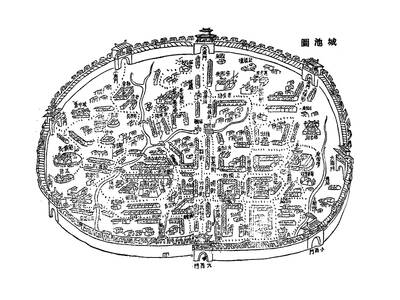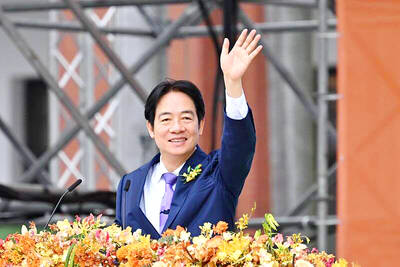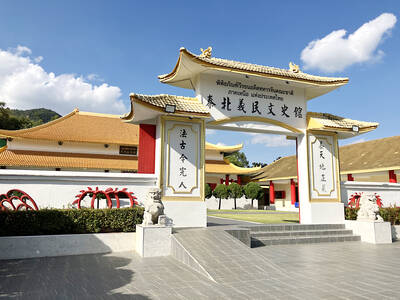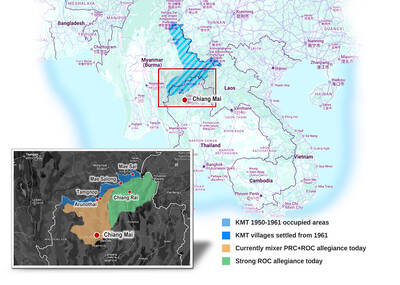Paris menswear displays ended Sunday with a flourish of flowing jackets, schoolboy bow-ties and profusely pleated pants as designers here refused to bow to the gloomy recession aesthetic that has cast a pall over other fashion capitals.
French label Lanvin put its money not on pinstripes or other business-friendly fabrics but sumptuous woolen knits that billowed or clung to the body in soft waves, creating a sensuous, romantic look.
Across town, Dior Homme was all hard lines and sharp angles.
Although the house sent out mostly black suits — a menswear staple in hard times — its innovative tailoring pushed the look forward.
British designer Paul Smith staged an energetic show that drew inspiration from the mischievous English schoolboy.
Throughout menswear week, which began on Thursday, other Paris designers also put flight and fancy above pure pocketbook concerns.
Highlights included John Galliano — who sent out models made up as Pan, the man-goat hybrid — and Givenchy, with its medieval sadomasochist look.
DIOR HOMME
Black suits that were anything but boring dominated at Dior Homme.
Asymmetrical cuts, strap and metalwork closures and heaps of pleats created an edgy, bold silhouette that played on volumes and contrast.
Designer Kris van Assche — who in 2007 replaced Hedi Slimane, the creator of the ultra-slim suit that was the house’s star piece — dared to go big, sending out billowy pants that bucked the overall trend in the Paris menswear shows toward slim trousers. A plethora of pleats fanning out from the low-slung waist band gave the pants an almost bubble cut through the hips and thighs.
Jackets dispensed with buttons, with one often asymmetrical flap closing over the another with hooks or graphic straps.
Turtlenecks, a recurring favorite at the Paris shows, were given a graphic twist. Cut in stiff white broadcloth, the generously draped necks stood straight up with contrasting black lining on the inside.
The entire show was black and white, and the closest thing to gray was a double-breasted overcoat in black and white bouclee.
French actress Beatrice Dalle praised the collection, which she called “really nice, really sober.”
“Although sobriety is not necessarily what I look for in a man,” Dalle said with a smile.
PAUL SMITH
The English schoolboy, with his tweed-heavy wardrobe and penchant for irreverent mixing and matching, had the run of the catwalk.
The collection was whimsical and fun even if Smith, whose flair for giving classics a twist has won him a worldwide following, didn’t stray far from his label’s hallmark style.
Tweed professor blazers were paired with slim plaid trousers and smart wool jackets were worn over cycling jerseys in bright primary colors. Flashes of hot pink lining peeked out from a blazer in oatmeal-colored houndstooth.
Bow-ties largely replaced conventional neckties, somehow managing to look dapper and not too out of place on the teenage models.
The same cannot be said for the show’s clunky plastic eyeglasses.
Those wearing the heavy, Clark Kent-style frames looked as if they were itching to rip off the nerd gear and re-emerge in tights and spandex.

May 26 to June 1 When the Qing Dynasty first took control over many parts of Taiwan in 1684, it roughly continued the Kingdom of Tungning’s administrative borders (see below), setting up one prefecture and three counties. The actual area of control covered today’s Chiayi, Tainan and Kaohsiung. The administrative center was in Taiwan Prefecture, in today’s Tainan. But as Han settlement expanded and due to rebellions and other international incidents, the administrative units became more complex. By the time Taiwan became a province of the Qing in 1887, there were three prefectures, eleven counties, three subprefectures and one directly-administered prefecture, with

President William Lai (賴清德) yesterday delivered an address marking the first anniversary of his presidency. In the speech, Lai affirmed Taiwan’s global role in technology, trade and security. He announced economic and national security initiatives, and emphasized democratic values and cross-party cooperation. The following is the full text of his speech: Yesterday, outside of Beida Elementary School in New Taipei City’s Sanxia District (三峽), there was a major traffic accident that, sadly, claimed several lives and resulted in multiple injuries. The Executive Yuan immediately formed a task force, and last night I personally visited the victims in hospital. Central government agencies and the

Among Thailand’s Chinese Nationalist Party (KMT) villages, a certain rivalry exists between Arunothai, the largest of these villages, and Mae Salong, which is currently the most prosperous. Historically, the rivalry stems from a split in KMT military factions in the early 1960s, which divided command and opium territories after Chiang Kai-shek (蔣介石) cut off open support in 1961 due to international pressure (see part two, “The KMT opium lords of the Golden Triangle,” on May 20). But today this rivalry manifests as a different kind of split, with Arunothai leading a pro-China faction and Mae Salong staunchly aligned to Taiwan.

As with most of northern Thailand’s Chinese Nationalist Party (KMT) settlements, the village of Arunothai was only given a Thai name once the Thai government began in the 1970s to assert control over the border region and initiate a decades-long process of political integration. The village’s original name, bestowed by its Yunnanese founders when they first settled the valley in the late 1960s, was a Chinese name, Dagudi (大谷地), which literally translates as “a place for threshing rice.” At that time, these village founders did not know how permanent their settlement would be. Most of Arunothai’s first generation were soldiers